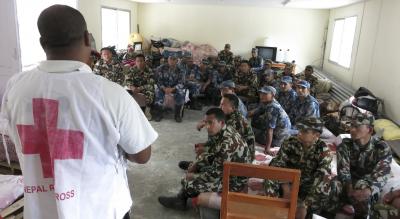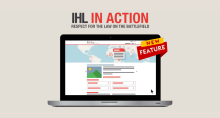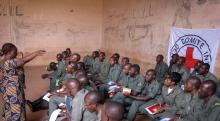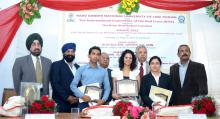Case prepared by Pierpaolo Castiglioni, Yiota Constantinidi, Fiammetta Ferioli, LL.M. students at Roma Tre University under the supervision of Giulio Bartolini (Professor) and Tommaso Natoli (Research assistant), Roma Tre University IHL Legal Clinic; with the contribution of Jemma Arman and Isabelle Gallino, LL.M. students at the Geneva Academy.
A. NEPAL: ARMY TRAINING TO INCLUDE HUMANITARIAN LAW
The Royal Nepalese Army has agreed to introduce international humanitarian law (IHL) as an integral part of its training programme, with effect from June 1997. The decision to include a training syllabus in IHL for all its five echelons from senior officers to junior ranks, and also for its UN operations, came as a result of the efforts made by the ICRC's Regional Delegation for South Asia, which has been interacting with the Royal Nepalese Army for over two years in conjunction with the Nepal Red Cross.
The first course in IHL, designed by the ICRC's Regional Delegate (South Asia) for Relations with Armed and Security Forces for Battalion Commanders, starts on 25 June 1997 at the Army Staff College in Tokha, Kathmandu. The course includes field and classroom exercises dealing mainly with the behaviour of soldiers in action. The International Red Cross and Red Crescent Movement, its relevance and the role of the ICRC and the Nepal Red Cross Society will also be discussed. The course is being conducted by Brig. Gen. Digamber S.J.B. Rana (Retd), Brig. Gen. Dipta P. Shah (Retd) and Lt. Col. Lal Bahadur Chand (Retd), who attended an extensive ICRC training programme last year and have been acting as ICRC regional consultants to the Royal Nepalese Army.
A Nepali version of the booklet Code of conduct for combatants has been prepared for the course, with a foreword by the Chief of Staff of the Royal Nepalese Army.
B. ICRC TRAINING TO ROYAL NEPALI ARMY MEN GOING ON
Kathmandu, September 7:
Though the International Committee of the Red Cross (ICRC) in Nepal has stopped visiting Royal Nepali Army (RNA) detention centres for about six months [...], it has been imparting training to army officers on the International Humanitarian Law.
Recently, two RNA officers were selected for doing a course on international military course on the International Humanitarian Law at the International Institute of Humanitarian Law in San Remo, Italy, under the ICRC sponsorship, an ICRC official said.
Other international organisations are sponsoring 15 RNA officers to do the same course. The ICRC official said the annual programme began a few years back. The two-week course will begin from October-end, RNA sources told this daily. The ICRC has been imparting training to RNA men inside the country as well. While a local consultant has been training the lower rank of the RNA on the law of the armed conflict, a New Delhi-based expatriate instructor, who looks after South Asia, has been frequently visiting Kathmandu to impart training to senior RNA men.
The ICRC official said the instructor spends at least two weeks for conducting training each time he visits Kathmandu. [...]
C. HUMAN RIGHTS IN THE NEPALESE ARMY
[Source: Human Rights in NA, (undated), Nepalese Army, available at: Link not available.]
[…]
[T]he Nepalese Army has integrated the teaching of IHRL and IHL into all army career courses. The DHR runs 6 days IHL basic course and in cooperation with International Committee of Red Cross (ICRC) it runs 5 days IHL advance course inside the organization. Until date [sic], all army personals [sic] will be sensitized on the subject matter of IHRL and IHL and more than 42000 army personnel have been trained in the subject matter by the directorate. Apart from IHL training, the Directorate runs 2 days Gender basic and 6 Days Gender Training of Trainers (ToT) for the military personals. The Directorate has trained 2800 army personals on the subject matter of Gender equality and UNSCR 1325 & 1820.
The Nepalese Army has issued various booklets and cards like the Soldier's Card, ROE Card, Human Rights booklet and Human Rights Year Book for the protection and promotion of IHRL and IHL in the organization. In order to facilitate commanders during any operation “Commander’s handbook on LOAC” published by the Directorate is being used. A documentary on Law of Armed Conflict has been produced.
The Nepalese Army in coordination and cooperation with UN Women has developed 6 different training manuals in Gender equality and UNSCR’s 1325 & 1820, a docu-drama named “Tara” which shows the principles of UNSCRs 1325 & 1820 and a documentary on “Women friendly environment within the Nepalese Army” has been made and are being used as training aid.
[…]
D. ARMY ACT, 2063 (2006)
[...]
20. Training and Induction:
(1) A person to be included in the organization of the Nepal Army shall be provided trainings and inductions on topics including military education, ethics, physical exercise, human rights and international humanitarian law.
(2) The arrangements of trainings and inductions pursuant to Subsection (1) shall be as prescribed.
[...]
Discussion
I. Classification of the Situation and Applicable Law
1. How would you qualify the situation between the Maoists and the Government of Nepal? What additional information would you require in order to make such a determination? (
GC I-IV, Art. 2 and
Art. 3;
P II, Art. 1)
II. Dissemination of IHL
3. Is there a similar obligation to disseminate IHRL to armed forces? Why is it important that armed forces also know IHRL?
4. Is the ICRC under the same legal obligation to respect and ensure respect for IHL as States? (
GC I-IV, Article 1,
CIHL, Rule 142) From where does the ICRC’s mandate to disseminate IHL arise? (
Movement Statutes, Art. 5, and
ICRC Statutes, Art. 4) Is it important that the ICRC and the Red Cross/Crescent national societies disseminate IHL even if States already fulfil their obligations in that regard? Why?
III. Elements Contributing to Respect for IHL
5. (Document A) How has the ICRC contributed to the introduction of IHL as an integral part of the Royal Nepalese Army’s training programme? What benefits do you see in the involvement of the ICRC in IHL training? May ICRC support to Governments in integrating IHL no longer be necessary at some point?
6. What, in your opinion, are the most efficient ways of disseminating IHL to armed forces? Are 6-day classroom courses sufficient? What other methods could you envisage?
7. What are the advantages and disadvantages of sending Nepalese officers to be trained in San Remo (Italy) with officers from other countries?
8. What rank of soldiers should receive IHL training? Should training be differentiated according to the rank of the soldiers involved? How might the principle of command responsibility motivate senior members of the armed forces to ensure the IHL training of members under their command? (
PI, Arts. 86/2,
87;
CIHL rule 152,
153)






